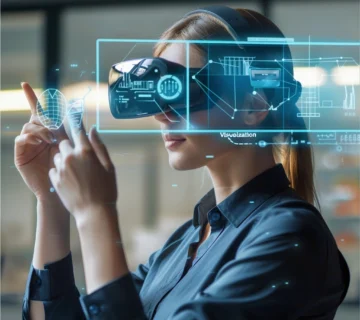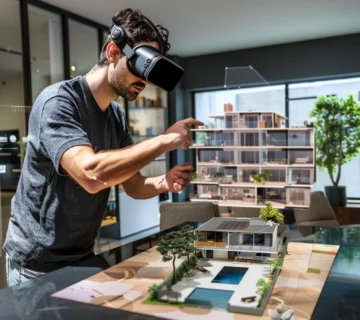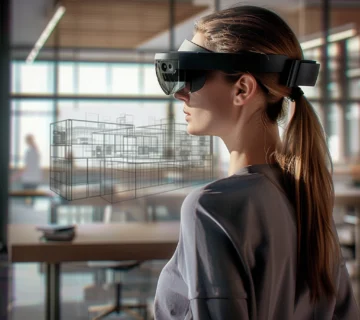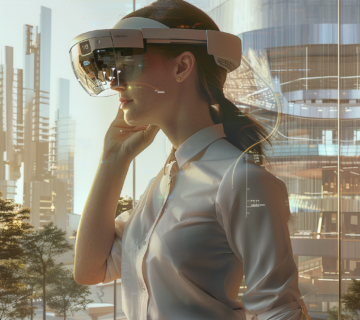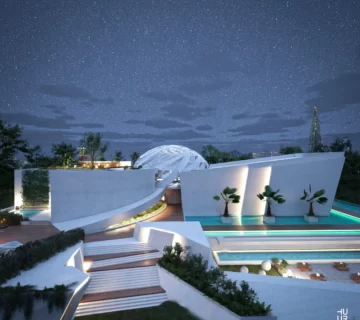Introduction:
AR visualization tools have profound implications for marketing and presentation
“Using augmented reality for architecture is not the most common practice. While AR technology is quite familiar to us in the context of online shopping and entertainment, its use in the architecture industry is rather a new thing. But that doesn’t mean you cannot benefit from it. This kind of CGI has a lot to offer.”[archicgi]
In the dynamic realm of architectural design, the incorporation of Exterior & Interior Visualizing in AR technology has ignited a wave of innovation and creative exploration. This transformative approach to design not only bridges the gap between virtual and physical environments but also reshapes traditional perspectives in the field.
Traditionally, architects have relied on conventional methods like 2D blueprints and static renderings to convey design concepts. However, these approaches often struggle to capture the full essence and spatial dynamics of architectural visions. Enter Exterior & Interior Visualizing in AR: a groundbreaking tool that immerses stakeholders into virtual models, offering a firsthand experience of proposed structures within their intended environments.
By leveraging Exterior & Interior Visualizing in AR, designers can provide clients with an unparalleled level of insight and understanding. Clients can navigate through virtual spaces, observing how natural light interacts with architectural elements and experiencing the flow of spaces in real-time. This immersive experience fosters deeper engagement and empowers clients to make informed decisions about design directions.
Moreover, Exterior & Interior Visualizing in AR facilitates a collaborative design process, allowing for seamless communication and iteration. Designers can incorporate client feedback directly into virtual models, making adjustments and refinements on the fly. This iterative approach encourages experimentation and innovation, leading to more creative and customized design solutions.
In conclusion, Exterior & Interior Visualizing in AR is reshaping the landscape of architectural design by offering a more immersive, collaborative, and innovative approach to design exploration. As this technology continues to evolve, its impact on the architectural industry will only grow, pushing the boundaries of creativity and transforming traditional design perspectives into visionary realities.
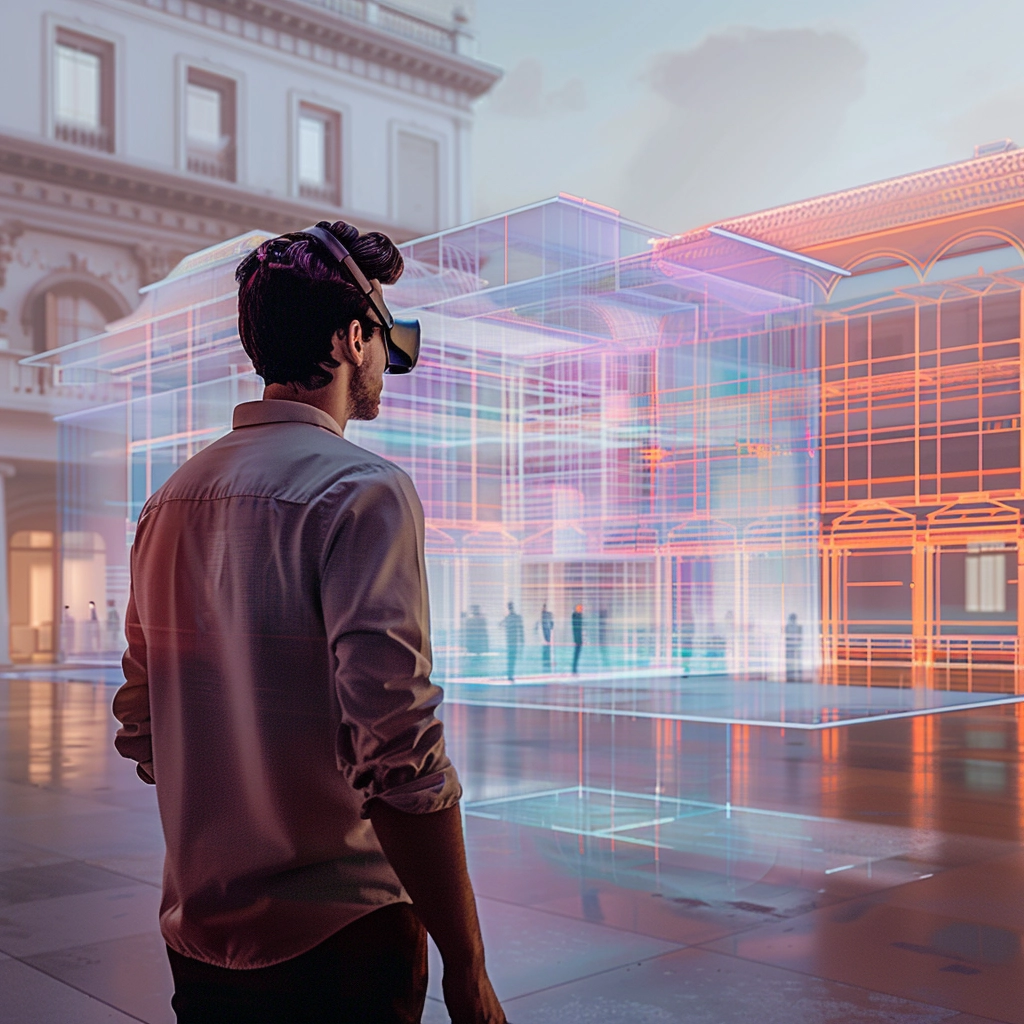
Augmented reality design
Blueprint 1: Design Visualization Utilize augmented reality to create interactive and immersive visualizations of architectural designs. With AR technology, stakeholders can explore proposed buildings and structures in real-time, gaining a deeper understanding of spatial relationships, materials, and aesthetics.
Blueprint 2: Client Collaboration Augmented reality facilitates collaborative design processes by allowing clients to provide feedback and suggestions directly within virtual models. By overlaying digital designs onto physical spaces, clients can visualize concepts more effectively and participate actively in the design evolution.
Blueprint 3: Site Analysis Leverage AR to conduct site analysis and assess environmental factors such as sunlight exposure, shadows, and views. By overlaying digital data onto physical landscapes, architects can make more informed decisions about building placement, orientation, and sustainability features.
Blueprint 4: Construction Planning AR technology enables architects to create detailed 3D models of building components and systems, such as structural elements, MEP (mechanical, electrical, plumbing) systems, and interior finishes. These virtual blueprints aid in construction planning, coordination, and communication among project teams.
Blueprint 5: Presentation and Marketing Augmented reality enhances architectural presentations and marketing materials by creating interactive and engaging experiences for clients and investors. With AR-enabled brochures, websites, and presentations, architects can showcase their projects compellingly and memorably, attracting potential clients and investors.
Overall, integrating augmented reality into Exterior & interior visualizing in AR in architectural processes revolutionizes the way buildings are designed, visualized, and communicated. By harnessing the power of AR technology, architects can create more innovative, sustainable, and client-centered designs while streamlining collaboration and decision-making throughout the project lifecycle.
Exploring Exterior & Interior Visualizing: A Comprehensive Perspective
Exterior & interior visualizing refers to the process of creating virtual representations of both the exterior and interior spaces of buildings or structures. This visualization technique utilizes various tools and technologies, including computer-aided design (CAD) software, rendering engines, and increasingly, augmented reality (AR) and virtual reality (VR) platforms.
In exterior visualization, architects and designers create digital models of buildings, landscapes, and surrounding environments. These models are then rendered with realistic textures, lighting, and materials to provide an accurate representation of how the exterior of the building will look once constructed. Exterior visualizations are often used for architectural presentations, marketing materials, and urban planning.
Interior visualizing :
Interior visualizing, on the other hand, focuses on creating virtual representations of the interior spaces within buildings. This may include rooms, corridors, lobbies, and other interior elements. Interior visualizations allow designers to experiment with different layouts, furniture arrangements, color schemes, and materials to achieve the desired aesthetic and functionality. Interior visualizations are commonly used in interior design projects, real estate marketing, and architectural visualization.
Exterior & interior visualizing is essential for architects, designers, and clients to visualize and communicate design concepts effectively. By creating realistic virtual representations of both the exterior and interior spaces, stakeholders can better understand how the building will look and function in the real world. This helps to streamline the design process, facilitate decision-making, and ensure that the final design meets the client’s requirements and expectations.
Advent of AR and VR technologies:
With the advent of AR and VR technologies, exterior & interior visualizing has become even more immersive and interactive. AR and VR platforms allow users to experience virtual environments in real-time, enabling them to explore and interact with architectural designs from different perspectives. This enhances the visualization process and provides stakeholders with a more immersive and engaging experience.
Overall, exterior & interior visualizing plays a crucial role in the architectural design process, helping architects and designers bring their ideas to life and communicate their vision effectively to clients and stakeholders. Whether through traditional rendering techniques or emerging AR and VR technologies, visualizing both the exterior and interior spaces of buildings is essential for creating successful architectural projects.
Designing Tomorrow: A Glimpse into Innovative Design Perspectives in 2024
Augmented reality in architecture
1.Exterior Visualization: Augmented reality in architecture revolutionizes exterior design visualization through “Exterior & interior visualizing in AR”. Architects can overlay virtual models of buildings onto physical environments, Augmented reality in construction, enabling clients to experience proposed structures in their intended surroundings. This immersive experience provides stakeholders with a realistic preview of exteriors, including materials, textures, and spatial relationships.
2.Interior Visualization: With “Exterior & interior visualizing in AR”, architects can also create interactive interior visualizations that allow clients to explore the layout, furnishings, and finishes of buildings. By overlaying virtual interiors onto physical spaces, stakeholders can visualize how spaces will look and feel once constructed, facilitating informed decision-making and enhancing design collaboration.
3.Design Iteration: Augmented reality facilitates iterative design processes by enabling architects to make real-time adjustments to virtual models during client meetings or presentations. With “Exterior & interior visualizing in AR”, designers can easily modify elements such as building massing, façade treatments, or interior layouts, allowing for quick exploration of design alternatives and client preferences.
4.Stakeholder Engagement: “Exterior & interior visualizing in AR” enhances stakeholder engagement by providing a more immersive and interactive design experience. Clients, investors, and project team members can actively participate in design reviews, offering feedback and suggestions directly within virtual models. This collaborative approach fosters greater buy-in and ensures that project requirements are met effectively.
5.Marketing and Presentation: Augmented reality transforms architectural presentations and marketing materials into engaging experiences with “Exterior & interior visualizing in AR”. Architects can create AR-enabled brochures, websites, or presentations that allow potential clients to explore proposed projects in a virtual environment. This interactive showcase not only captivates audiences but also showcases the design vision and capabilities of the architectural firm in AR development services.
In summary, “Exterior & interior visualizing in AR” revolutionizes the architectural design process by providing immersive, interactive, and collaborative experiences for stakeholders. By leveraging augmented reality technology, architects can visualize, iterate, and communicate design concepts more effectively, ultimately leading to better-informed decisions, enhanced stakeholder engagement, and more successful architectural projects.

AR visualization tools in Exterior & interior visualizing in AR technology:
AR visualization tools are software applications or platforms that enable users to create, view, and interact with augmented reality content for various purposes, including design, education, gaming, and marketing. These tools leverage augmented reality technology to overlay digital information, such as 3D models, animations, or interactive elements, onto the real-world environment captured by a device’s camera.
Exterior & interior visualizing in AR represents a significant leap in architectural visualization, blending the virtual and physical worlds seamlessly. This innovative approach allows architects, designers, and clients to experience architectural designs in a more immersive and interactive manner. With AR technology, users can overlay virtual models of buildings onto real-world environments, providing a realistic preview of how structures will look and feel once constructed.
Exterior visualization:
In exterior visualization, AR enables stakeholders to view proposed buildings in their intended surroundings, considering factors such as scale, context, and lighting. This immersive experience helps clients make informed decisions and provides architects with valuable feedback during the design process. Similarly, interior visualization in AR allows users to explore interior spaces, experimenting with different layouts, materials, and furnishings in real-time.
The use of AR in exterior & interior visualizing also facilitates collaboration and communication among project stakeholders. Design teams can use AR tools to review designs, make annotations, and discuss ideas in real-time, regardless of their physical location. This collaborative approach fosters creativity, streamlines communication, and accelerates the design iteration process.
Overall, exterior & interior visualizing in AR transforms the way architectural designs are conceived, communicated, and experienced. By leveraging the immersive capabilities of AR technology, architects can create more compelling designs, foster greater collaboration, and elevate the overall quality of architectural projects. As AR continues to evolve, its role in architectural visualization is poised to become even more central, driving innovation and reshaping the future of architectural practice.
Augmented reality in architectural visualization
Augmented reality architectural visualization is a cutting-edge technology that revolutionizes how architects, designers, and clients envision and interact with architectural designs. By superimposing virtual elements onto real-world environments, AR architectural visualization enables stakeholders to experience buildings and spaces in a more immersive and interactive manner.
One of the key advantages of AR architectural visualization is its ability to provide a realistic preview of proposed designs within their intended surroundings. Clients can use AR-enabled devices, such as smartphones or tablets, to view virtual models overlaid onto physical spaces, allowing them to visualize how buildings will look and feel once constructed. This immersive experience helps clients make more informed decisions and provides architects with valuable feedback during the design process.
Moreover, AR architectural visualization facilitates collaborative design exploration by allowing multiple stakeholders to interact with virtual models simultaneously. Design teams can use AR tools to review designs, make annotations, and discuss ideas in real-time, regardless of their physical location. This collaborative approach fosters creativity, streamlines communication, and accelerates the design iteration process.
AR technology solutions:
AR architectural visualization also enhances the presentation and marketing of architectural projects. Architects can create interactive AR experiences that showcase their designs to clients, investors, and the public in a more engaging and memorable way. By allowing users to explore virtual buildings and spaces from different perspectives, AR visualization helps convey the design intent and captures the imagination of viewers.
Overall, augmented reality architectural visualization is transforming the way architectural designs are conceived, communicated, and experienced. By leveraging the immersive capabilities of AR technology, architects can create more compelling designs, foster greater collaboration, and elevate the overall quality of architectural projects. As AR continues to evolve, its role in architectural visualization is poised to become even more central, driving innovation and reshaping the future of architectural practice.
Immersive Design: Exploring Exterior & Interior Visualizing in AR
In the realm of architectural design, the integration of augmented reality (AR) technology has ushered in a new era of immersive visualization. Exterior & interior visualizing in AR offers architects, designers, and clients a transformative experience, blurring the lines between the physical and digital worlds.
With Exterior & interior visualization in AR, architects can craft virtual models of buildings and overlay them onto real-world environments. This allows stakeholders to explore proposed structures in their intended context, providing a realistic preview of how the designs will interact with their surroundings. Whether it’s visualizing a sleek skyscraper in a bustling urban landscape or envisioning a cozy interior nestled within a tranquil neighborhood, AR brings architectural concepts to life with unparalleled fidelity.
The use of Exterior & interior visualizing in AR extends beyond mere visualization; it fosters collaboration and enhances decision-making throughout the design process. Design teams can gather around a virtual model, making annotations, discussing design iterations, and exploring different options in real time. This collaborative approach not only streamlines communication but also empowers clients to actively participate in the design evolution, ensuring that the final product meets their expectations.
Moreover, Exterior & interior visualization in AR revolutionizes architectural presentations and marketing materials. Instead of static renderings or blueprints, architects can now offer clients interactive AR experiences, allowing them to explore every detail of a design from multiple perspectives. This immersive showcase captivates audiences and provides a deeper understanding of the design vision, ultimately strengthening client relationships and attracting new opportunities.
Immersive Design: Exploring Exterior & Interior Visualizing in AR
In the realm of architectural design, the integration of augmented reality (AR) technology has ushered in a new era of immersive visualization. Exterior & interior visualizing in AR offers architects, designers, and clients a transformative experience, blurring the lines between the physical and digital worlds.
With Exterior & interior visualization in AR, architects can craft virtual models of buildings and overlay them onto real-world environments. This allows stakeholders to explore proposed structures in their intended context, providing a realistic preview of how the designs will interact with their surroundings. Whether it’s visualizing a sleek skyscraper in a bustling urban landscape or envisioning a cozy interior nestled within a tranquil neighborhood, AR brings architectural concepts to life with unparalleled fidelity.
A virtual model:
The use of Exterior & interior visualizing in AR extends beyond mere visualization; it fosters collaboration and enhances decision-making throughout the design process. Design teams can gather around a virtual model, make annotations, discuss design iterations, and explore different options in real time. This collaborative approach not only streamlines communication but also empowers clients to actively participate in the design evolution, ensuring that the final product meets their expectations.
Moreover, Exterior & interior visualization in AR revolutionizes architectural presentations and marketing materials. Instead of static renderings or blueprints, architects can now offer clients interactive AR experiences, allowing them to explore every detail of a design from multiple perspectives. This immersive showcase captivates audiences and provides a deeper understanding of the design vision, ultimately strengthening client relationships and attracting new opportunities.
In addition to enhancing the design process and client engagement, Exterior & interior visualization in AR has practical applications in construction and project management. AR-enabled devices can be used on construction sites to overlay digital models onto physical spaces, aiding in visualization, quality control, and progress tracking. This integration of AR technology into the construction workflow improves efficiency, reduces errors, and accelerates project timelines.
The Impact of Exterior & Interior Visualizing in AR’ in Real Estate Marketing:
In the domain of real estate marketing, the integration of AR technology has ushered in a transformative era, particularly through the compelling avenue of “Exterior & Interior Visualizing in AR.” This groundbreaking application allows potential buyers to transcend traditional property viewing limitations.
Through AR, prospective clients can virtually explore properties with a heightened sense of immersion, offering an unparalleled opportunity to envision exterior facades and interior spaces in an interactive and realistic manner. This not only facilitates a more informed decision-making process for buyers but also revolutionizes how real estate professionals showcase their listings.
With “Exterior & Interior Visualizing in AR,” the virtual exploration of properties becomes a dynamic and engaging experience. Prospective buyers can navigate through the exterior of a property, visualizing how it harmonizes with its surroundings, and seamlessly transition to immersive interior views. This innovative approach not only caters to the evolving expectations of tech-savvy consumers but also provides a sophisticated and interactive platform for real estate professionals to present their offerings.
Benefits of incorporating AR in real estate marketing:
Moreover, Exterior & interior visualizing in AR and the benefits of incorporating AR in real estate marketing extend beyond mere visualization. This technology enables the overlay of additional information onto properties, such as highlighting specific architectural features, showcasing potential renovations, or providing details about nearby amenities. The interactive nature of AR enhances the storytelling aspect of property presentations, creating a more engaging narrative for potential buyers.
From a practical perspective, “Exterior & Interior Visualizing in AR” expedites the property viewing process, allowing buyers to explore multiple listings efficiently and remotely. This not only saves time for both buyers and real estate professionals but also widens the reach of property marketing efforts. Virtual property tours, enriched by AR technology, transcend geographical constraints, opening up opportunities for global audiences to explore and consider real estate options from the comfort of their current location.
In conclusion, the marriage of real estate marketing with “Exterior & Interior Visualizing in AR” represents a paradigm shift in the industry. This innovative application not only enhances the visualization of properties but also redefines the entire property viewing experience. As AR technology continues to advance, the integration of “Exterior & Interior Visualizing in AR” is poised to become a standard practice, setting new benchmarks for immersive and interactive real estate presentations.
Conclusion:
In conclusion, AR visualization tools represent a pivotal gateway to unlocking the full potential of augmented reality technology across diverse industries and applications. From game development to education, marketing, and beyond, these tools empower creators to craft immersive and interactive experiences that seamlessly blend the virtual and physical worlds. Exterior & interior visualizing in AR uses variety of platforms like ,Unity3D, Unreal Engine, Vuforia, ARCore, ARKit, ZapWorks, and Lens Studio are just a few examples of the wide array of platforms and frameworks available for building AR content.
By leveraging these tools, developers, designers, educators, and marketers can push the boundaries of creativity, innovation, and engagement, ultimately reshaping how we interact with digital information in our everyday lives. As AR technology continues to evolve and become more accessible, the possibilities for creating impactful and memorable AR experiences are virtually limitless





